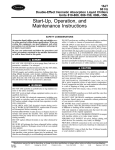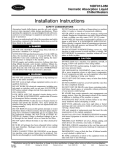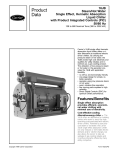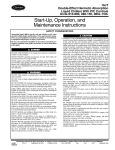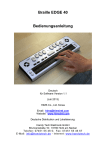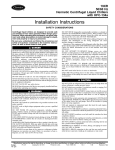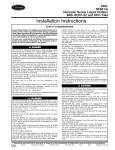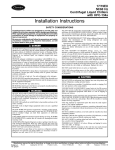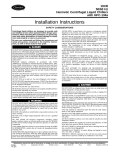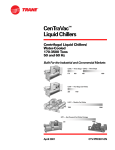Download Carrier 16JT080-150 Specifications
Transcript
16JT810-880, 080-150, 080L-150L Double-Effect Hermetic Absorption Liquid Chillers Installation Instructions SAFETY CONSIDERATIONS Absorption liquid chillers provide safe and reliable service when operated within design specifications. When operating this equipment, use good judgment and safety precautions to avoid damage to equipment and property or injury to personnel. Be sure you understand and follow the procedures and safety precautions contained in the chiller instructions as well as those listed in this guide. DO NOT USE OXYGEN or air to purge lines, leak test, or pressurize a chiller. Use nitrogen. NEVER EXCEED specified test pressures. For the 16JT chiller, the maximum pressure is 12 psig (83 kPa). WEAR goggles and suitable protective clothing when handling lithium bromide, octyl alcohol, inhibitor, lithium hydroxide, and hydrobromic acid. IMMEDIATELY wash any spills from the skin with soap and water. IMMEDIATELY FLUSH EYES with water and consult a physician. DO NOT USE eyebolts or eyebolt holes to rig chiller sections or the entire assembly. DO NOT work on high-voltage equipment unless you are a qualified electrician. DO NOT WORK ON electrical components, including control panels or switches, until you are sure ALL POWER IS OFF and no residual voltage can leak from capacitors or solidstate components. LOCK OPEN AND TAG electrical circuits during servicing. IF WORK IS INTERRUPTED, confirm that all circuits are deenergized before resuming work. NEVER DISCONNECT safety devices or bypass electric interlocks while operating the chiller. Also, never operate the chiller when any safety devices are not adjusted and functioning normally. DO NOT syphon lithium bromide or any other chemical by mouth. BE SURE all hydrogen has been exhausted before cutting into purge chambers. Hydrogen mixed with air can explode when ignited. WHEN FLAMECUTTING OR WELDING on an absorption chiller, some noxious fumes may be produced. Ventilate the area thoroughly to avoid breathing concentrated fumes. DO NOT perform any welding or flamecutting to a chiller while it is under a vacuum or pressurized condition. NEVER APPLY an open flame or live steam to a refrigerant cylinder. Dangerous overpressure can result. When necessary to heat a cylinder, use only warm (110 F [43 C]) water. DO NOT REUSE disposable (nonreturnable) cylinders or attempt to refill them. It is DANGEROUS AND ILLEGAL. When cylinder is emptied, evacuate remaining gas pressure, loosen the collar, and unscrew and discard the valve stem. DO NOT INCINERATE. DO NOT ATTEMPT TO REMOVE fittings, covers, etc., while the chiller is under pressure or while chiller is running. DO NOT climb over a chiller. Use platform, catwalk, or staging. Follow safe practices when using ladders. DO NOT STEP ON chiller piping. It might break or bend and cause personal injury. USE MECHANICAL EQUIPMENT (crane, hoist, etc.) to lift or move inspection covers or other heavy components. Even if components are light, use such equipment when there is a risk of slipping or losing your balance. VALVE OFF AND TAG steam, water, or brine lines before opening them. DO NOT LOOSEN waterbox cover bolts until the water box has been completely drained. DO NOT VENT OR DRAIN waterboxes containing industrial brines, liquid, gases, or semisolids without permission from your process control group. BE AWARE that certain automatic start arrangements can engage starters. Open the disconnects ahead of the starters in addition to shutting off the chiller or pump. USE only repaired or replacement parts that meet the code requirements of the original equipment. DO NOT ALLOW UNAUTHORIZED PERSONS to tamper with chiller safeties or to make major repairs. PERIODICALLY INSPECT all valves, fittings, piping, and relief devices for corrosion, rust, leaks, or damage. PROVIDE A DRAIN connection in the vent line near each pressure relief device to prevent a build-up of condensate or rain water. IMMEDIATELY wipe or flush the floor if lithium bromide or octyl alcohol is spilled on it. Manufacturer reserves the right to discontinue, or change at any time, specifications or designs without notice and without incurring obligations. Book 2 PC 211 Catalog No. 531-611 Printed in U.S.A. Form 16JT-3SI Pg 1 8-96 Replaces: 16JT-2SI Tab 5b If the last five digits of the serial number are 80XXX (where XXX stands for the last three digits of the serial number), the model comes with fusible plug drain piping and rupture disc piping; if the last five digits are 92XXX, the model comes with rupture disc piping only. CONTENTS Page SAFETY CONSIDERATIONS . . . . . . . . . . . . . . . . . . . 1 INTRODUCTION . . . . . . . . . . . . . . . . . . . . . . . . . . . . . . 2 General . . . . . . . . . . . . . . . . . . . . . . . . . . . . . . . . . . . . . . 2 Job Data . . . . . . . . . . . . . . . . . . . . . . . . . . . . . . . . . . . . 2 RECEIVING THE CHIILLER . . . . . . . . . . . . . . . . . . . 2,3 Identify Chiller . . . . . . . . . . . . . . . . . . . . . . . . . . . . . . . 2 Inspect Shipment . . . . . . . . . . . . . . . . . . . . . . . . . . . . 2 One-Piece Chillers: Check Shipping Vacuum . . . . . . . . . . . . . . . . . . . . . . . . . . . . . . . . . . . 2 Two-Piece Chillers: Check Shipping Pressure . . . . . . . . . . . . . . . . . . . . . . . . . . . . . . . . . . 2 Provide Chiller Protection . . . . . . . . . . . . . . . . . . . . 2 RIGGING AND POSITIONING . . . . . . . . . . . . . . . . . 3-8 Rig One-Piece Units . . . . . . . . . . . . . . . . . . . . . . . . . . 3 Rig Two-Piece Units . . . . . . . . . . . . . . . . . . . . . . . . . . 3 • PREPARATION • RIGGING Position and Level the Equipment . . . . . . . . . . . . 8 CHIILLER ASSEMBLY . . . . . . . . . . . . . . . . . . . . . . . 8-10 Assemble Two-Piece Units . . . . . . . . . . . . . . . . . . . 8 Purge Exhaust Assembly . . . . . . . . . . . . . . . . . . . . . 8 Chiller Leak Test . . . . . . . . . . . . . . . . . . . . . . . . . . . . . 8 Chiller Evacuation . . . . . . . . . . . . . . . . . . . . . . . . . . . 8 Connect Water Piping . . . . . . . . . . . . . . . . . . . . . . . . 9 Install Steam and Condensate Piping . . . . . . . . 10 Fusible Plug Drain Piping . . . . . . . . . . . . . . . . . . . 10 Rupture Disc Piping . . . . . . . . . . . . . . . . . . . . . . . . . 10 INSULATION AND PAINT . . . . . . . . . . . . . . . . . . . . . 11 Insulation (If Required) . . . . . . . . . . . . . . . . . . . . . . 11 • COLD SURFACES • HOT SURFACES Final Paint Coat (If Required) . . . . . . . . . . . . . . . . 11 CONTROLS AND WIRING . . . . . . . . . . . . . . . . . . . . 11 Two-Piece Chiller Connections . . . . . . . . . . . . . . . 11 Chillers With Electro-Mechanical Controls . . . . 11 • CAPACITY CONTROL VALVE(S) • EXTERNAL WIRING • SENSOR ELEMENTS Chillers With PIC Controls . . . . . . . . . . . . . . . . . . . 11 • CAPACITY CONTROL VALVE(S) • EXTERNAL WIRING • SENSOR ELEMENTS INITIAL SOLUTION AND REFRIGERANT CHARGING . . . . . . . . . . . . . . . . . . . . . . . . . . . . . . . 12 Fig. 1 — Model Number Nomenclature For 16JT chillers sizes 810 to 880, the evaporator and absorber are located side by side; for sizes 080 to 150 and 080L to 150L, the evaporator is located above the absorber. Inspect Shipment (Fig. 2) — One-piece chillers are at a deep vacuum when shipped. Do not open any valves until the vacuum has been noted. Refer to One-Piece Chillers: Check Shipping Vacuum below. NOTE: Chillers shipped in 2 pieces are under nitrogen pressure. Inspect for shipping damage while chiller is still on shipping conveyance. If chiller appears to be damaged or has been torn loose from its anchorage, have it examined by transportation inspectors before removal. Forward claim papers directly to transportation company. Manufacturer is not responsible for any damage incurred in transit. Check all items against shipping list. Immediately notify the nearest Carrier Air Conditioning office if any item is missing. To prevent loss or damage, leave all parts in original packages until installation. One-Piece Chillers: Check Shipping Vacuum — To check for leaks that have occurred during shipment on one-piece chillers: 1. Connect an absolute pressure gage to a service valve. 2. Record the absolute pressure of the assembly. If the vessel pressure is greater than 0.28 in. (7 mm) of mercury, the chiller has acquired a leak in shipping and must be leak tested. Refer to the Chiller Leak Test section for instructions. INTRODUCTION Two-Piece Chillers: Check Shipping Pressure — To check for leaks that have occurred during shipment General — The 16JT chiller is factory assembled, wired, and leak tested. Installation (not by Carrier) consists primarily of establishing water, steam, and electrical services to the chiller. Rigging, installation, insulation, field wiring, and field piping are the responsibility of the contractor and/or customer. Carrier has no installation responsibilities for the equipment. on two-piece chillers: 1. Connect a pressure gage (30 psig [200 kPa]) to a service valve on each piece. Two-piece chillers are pressurized with nitrogen to 5 psig (34 kPa). 2. If the vessel has lost its pressure, it has acquired a leak during shipping and must be leak tested after positioning and assembly. Refer to the Chiller Leak Test section for instructions. Job Data — Necessary information consists of chiller location drawings, piping drawings, field wiring diagrams, and a rigging guide. Provide Chiller Protection — If the chiller will not be installed immediately, it is very important to use a drop cloth or plastic cover to protect the chiller from construction dirt and moisture before installation. Also, do not remove protective shipping cover on control panel until ready to use. RECEIVING THE CHIILLER Identify Chiller — The chiller model number and serial number are stamped on the chiller identification plate. Check this information against shipping papers and job data. For information on model number nomenclature, see Fig. 1. The 16JT comes with either electro-mechanical controls or Product Integrated Controls (PIC), depending on when it was manufactured. 2 16JT SIZES 810-880 2 3 4 1 1 2 3 4 5 6 7 8 9 5 — — — — — — — — — LEGEND High-Stage Generator Low-Stage Generator (Hidden) Condenser Purge Storage Chamber Control Panel Nameplate (On Support Leg) Solution Heat Exchangers Absorber Evaporator 9 8 6 7 16JT SIZES 080-150, 080L-150L 3 4 5 6 2 7 1 13 8 1 — High-Stage Generator 2 — Hot Vapor Line from the High-Stage Generator 3 — Low-Stage Generator (Hidden) 4 — Condenser 5 — Control Panel 6 — Purge Storage Chamber 7 — Auxiliary Evacuation Valve 8 — Refrigerant Sump Box 9 — Nameplate 10 — Refrigerant Pump 11 — Solution Heat Exchanger 12 — Absorber 13 — Evaporator 12 9 10 11 Fig. 2 — Chiller Components PREPARATION — Two-piece units must be prepared for installation before they can be rigged. Refer to Fig. 7-10. 1. Open the auxiliary evacuation valves to relieve pressure in the absorber-evaporator shell. 2. Open the shipping valve on the generator-condenser assembly to relieve pressure. RIGGING AND POSITIONING Rigging procedures vary depending on whether the chiller is shipped in one or 2 pieces. Lifting the chiller from points other than those specified may result in serious damage and personal injury. Rigging equipment and procedures must be adequate for chiller weights and sizes. Refer to Tables 1 and 2 for chiller weights, and Fig. 3 and 4 for overall dimensions. To keep foreign particles out of the chiller, do not leave chiller open any longer than necessary. Rig One-Piece Units (Fig. 5) — Lift the entire assembly with cable slings placed under the lower shell, as shown in Fig. 5, to distribute and balance the weight. Do not remove any stock from pipe ends. Do not get slag inside chiller while flamecutting. Rig Two-Piece Units (Fig. 6) 3. Remove all piping end plates by flamecutting the end plate, and weld the flange around each outer diameter as shown in Fig. 7. Cut these pieces, as shown in Fig. 8, for proper reconnection. 4. Grind the cut pieces smooth for a close fit when the chiller pieces are assembled. If the chiller is assembled before it is rigged, to avoid damage to the chiller, do not lift under the generator shell or waterboxes. The chiller should be lifted under the absorber-evaporator shell. 3 DIMENSIONS (ft-in.) UNIT 16JT Overall Length Overall Width Overall Height Height A B C D* 810 9-10 6- 4 7- 7 7- 2 812 9-10 6- 4 7- 7 7- 2 814 9-10 6- 4 7- 7 7- 2 816 13-7 6-2 7-7 7-2 818 13-7 6-2 7-7 7-2 821 13-7 6-2 7-7 7-2 824 13-8 6-7 8-2 7-6 828 13-8 6-7 8-2 7-6 UNIT 16JT Overall Length A Overall Width B Overall Height C Height D* 836 17-6 6-6 8-4 7-1 841 17- 8 6-11 9- 1 7- 5 847 17- 8 6-11 9- 1 7- 5 854 17- 8 7- 4 9- 9 7-10 857 22-11 6-11 9- 8 8- 1 865 22-11 6-11 9- 8 8- 1 873 22-11 7- 4 9- 5 7- 8 880 23- 2 7- 7 9-11 7-11 832 17-6 6-6 8-4 7-1 DIMENSIONS (mm) UNIT 16JT Overall Length A Overall Width B Overall Height C Height D* 810 3000 1930 2310 2185 812 3000 1930 2310 2185 814 3000 1930 2310 2185 816 4140 1880 2310 2185 818 4140 1880 2310 2185 821 4140 1880 2310 2185 824 4165 2005 2490 2285 828 4165 2005 2490 2285 UNIT 16JT Overall Length A Overall Width B Overall Height C Height D* 836 5335 1980 2540 2160 841 5385 2110 2770 2260 847 5385 2110 2770 2260 854 5385 2235 2970 2390 857 6985 2110 2950 2460 865 6985 2110 2950 2460 873 6985 2235 2870 2335 880 7060 2310 3020 2415 832 5335 1980 2540 2160 *Standard shipping configuration for sizes 810-880 is one-piece. Dimension ‘‘D’’ is height of absorber-evaporator section for two-piece shipment. Removal of purge storage tank may reduce height further. NOTES: 1. All dimensions are approximate and do not take into account absorber-condenser crossover piping if not factory installed as standard. 2. For routine maintenance, allow 3 ft (1 m) clearance on all sides and 6 in. (150 mm) above chiller. 3. For service access, allow clearances as follows: a. For tube removal, allow space to equal ‘‘A’’ dimension (length) at either end of the chiller. b. For opening waterbox cover, allow space equal to half of ‘‘B’’ dimension (width) at end of chiller opposite nozzle. Fig. 3 — Dimensions, 16JT810-880 4 DIMENSIONS (ft-in.) UNIT 16JT Overall Length A Overall Width B Overall Height C Height D* 080 23- 0 8- 5 9-10 7-10 090 23-0 8-3 10-5 8-4 100 23- 0 8-10 11- 0 8- 9 110 23-3 9-2 11-7 9-4 120 23- 3 9- 7 12- 3 9-10 135 23-6 10-1 13-0 10-7 150 23-6 10-8 13-8 11-2 UNIT 16JT Overall Length A Overall Width B Overall Height C Height D* 080L 25-11 8- 5 9-10 7-10 090L 25-11 8- 3 10- 5 8- 4 100L 26- 0 8-10 11- 0 8- 9 110L 26-2 9-2 11-7 9-4 120L 26- 2 9- 7 12- 3 9-10 135L 26-6 10-1 13-0 10-7 150L 26-6 10-8 13-8 11-2 DIMENSIONS (mm) UNIT 16JT Overall Length A Overall Width B Overall Height C Height D* 080 7010 2565 3000 2390 090 7010 2515 3175 2540 100 7010 2690 3350 2665 110 7085 2795 3530 2845 120 7085 2920 3735 3000 135 7160 3075 3960 3225 150 7160 3250 4165 3405 UNIT 16JT Overall Length A Overall Width B Overall Height C Height D* 080L 7900 2565 3000 2390 090L 7900 2515 3175 2540 100L 7925 2690 3350 2665 110L 7975 2795 3530 2845 120L 7975 2920 3735 3000 135L 8075 3075 3960 3225 150L 8075 3250 4165 3405 *Standard shipping configuration for sizes 080-100 is one-piece, sizes 110-150 and 080L-150L are 2-piece. Dimension ‘‘D’’ is height of absorber-evaporator section for two-piece shipment. Removal of purge storage tank may reduce height further. NOTES: 1. All dimensions are approximate and do not take into account absorber-condenser crossover piping if not factory installed as standard. 2. For routine maintenance, allow 3 ft (1 m) clearance on all sides and 6 in. (150 mm) above chiller. 3. For service access, allow clearances as follows: a. For tube removal, allow space to equal ‘‘A’’ dimension (length) at either end of the chiller. b. For opening waterbox cover, allow space equal to half of ‘‘B’’ dimension (width) at end of chiller opposite nozzle. Fig. 4 — Dimensions, 16JT080-150, 080L-150L 5 Table 1 — Rigging Weights, One-Piece Shipment* UNIT 16JT 810 812 814 816 818 821 824 828 832 836 841 847 854 857 865 873 880 080 090 100 110 120 135 150 080L 090L 100L 110L 120L 135L 150L Table 2 — Rigging Weights, Two-Piece Shipment* WEIGHT WEIGHT lb 11,680 11,900 12,120 16,090 16,310 16,530 16,970 17,410 20,275 20,935 23,365 24,025 26,450 31,740 32,400 35,265 38,135 44,080 49,590 54,440 59,505 66,120 71,630 77,140 50,695 56,865 60,610 65,020 71,405 83,755 87,060 UNIT 16JT kg 5 300 5 400 5 500 7 300 7 400 7 500 7 700 7 900 9 200 9 500 10 600 10 900 12 000 14 400 14 700 16 000 17 300 20 000 22 500 24 700 27 000 30 000 32 500 35 000 23 000 25 800 27 500 29 500 32 400 38 000 39 500 810 812 814 816 818 821 824 828 832 836 841 847 854 857 865 873 880 080 090 100 110 120 135 150 080L 090L 100L 110L 120L 135L 150L *Standard shipping configuration for sizes 810-880 and 080-100 is one piece. (Two-piece shipment for these sizes is optional.) Standard shipping configuration for sizes 110-150 and 080L-150L is two pieces. (One-piece shipment for these sizes is optional.) Absorber/Evaporator lb kg 8,595 3 900 8,815 4 000 9,035 4 100 11,460 5 200 11,680 5 300 11,680 5 300 11,900 5 400 12,120 5 500 13,885 6 300 14,325 6 500 16,090 7 300 16,530 7 500 18,295 8 300 22,040 10 000 22,480 10 200 23,005 10 800 26,010 11 800 29,755 13 500 34,160 15 500 37,470 17 000 41,875 19 000 47,385 21 500 51,795 23 500 55,100 25 000 35,265 16 000 40,335 18 300 42,980 19 500 45,845 20 800 50,690 23 000 59,510 27 000 62,845 28 500 Generator/Condenser lb kg 3,085 1 400 3,085 1 400 3,085 1 400 4,630 2 100 4,630 2 100 4,850 2 200 5,070 2 300 5,290 2 400 6,390 2 900 6,610 3 000 7,275 3 300 7,495 3 400 8,155 3 700 9,700 4 400 9,920 4 500 11,460 5 200 12,125 5 500 14,325 6 500 15,430 7 000 16,970 7 700 17,630 8 000 18,735 8 500 19,835 9 000 22,040 10 000 15,430 7 000 16,530 7 500 17,630 8 000 19,175 8 700 20,715 9 400 24,245 11 000 24,245 11 000 *Standard shipping configuration for sizes 810-880 and 080-100 is one piece. (Two-piece shipment for these sizes is optional.) Standard shipping configuration for sizes 110-150 and 080L-150L is two pieces. (One-piece shipment for these sizes is optional.) Fig. 5 — Rigging One-Piece Units Fig. 6 — Rigging Two-Piece Units 6 Fig. 8 — Flamecutting and Welding Detail Fig. 7 — Weld Breaking and Weld Connection Instructions 1 2 3 4 5 — — — — — 6 7 8 9 — — — — 1 2 3 4 5 6 7 8 9 10 11 Weak solution to high-stage generator Strong solution from high-stage generator Weak solution from level control box Weak solution to level control box Strong solution from high-temperature heat exchanger to low-stage generator Strong solution overflow from low-stage generator Strong solution from low-stage generator Purge line (condenser to absorber) Refrigerant from condenser — — — — — — — — — — — Weak solution from level control box Weak solution to high-stage generator Strong solution from high-stage generator Weak solution to level control box Cooling water connection (absorber to condenser) Refrigerant from condenser Purge line (condenser to absorber) Refrigerant from condenser Strong solution from high-temperature heat exchanger Strong solution from low-stage generator Strong solution overflow from low-stage generator Fig. 10 — Chiller Configuration 16JT080-150, 080L-150L Fig. 9 — Chiller Configuration 16JT810-880 7 RIGGING — The 2 pieces are the generator-condenser shell assembly and the absorber-evaporator shell assembly. 1. Lift each assembly with cable slings placed under the shells, as shown in Fig. 6, to distribute and balance the weight. 2. Position and level the absorber-evaporator assembly first. See Position and Level the Equipment section. 3. Move the generator-condenser assembly to the top of the absorber-evaporator assembly. Match connecting piping for the generator-condenser and absorber-evaporator assemblies. Make sure stamped serial numbers accompanying the match marks correspond on both assemblies. Purge Exhaust Assembly — Install the purge exhaust assembly on the purge exhaust valve as shown in Fig. 12. Position and Level the Equipment — Isolation pads are not necessary for most installations. However, for cases where isolation pads are required, refer to Fig. 11 for typical installation. It is not necessary to level the generator-condenser assembly, because both assemblies are designed to be level when the absorber-evaporator assembly has been leveled. The 16JT chiller must be level within 1⁄4 in. per 20 ft (6.3 mm per 6 m), both lengthwise and diagonally. To level the absorber-evaporator, proceed as follows: 1. Completely fill a 50-ft (15 m) length of clear flexible tubing with water. 2. Use the water gage and leveling reference points stamped on the absorber-evaporator shell to level the absorberevaporator. 3. Level the absorber-evaporator with shims until requirements are met. If an isolation assembly is used, shim under the soleplate. 4. Set anchor bolts with concrete to secure absorberevaporator in place. Fig. 12 — Purge Exhaust Assembly Chiller Leak Test — All field-welded joints on the chiller must be leak tested before starting the chiller. Leak test as follows: 1. Close all external service valves. 2. If the chiller is under vacuum, bring it to atmospheric pressure with dry nitrogen. 3. Pressurize to 6 psig (40 kPa) with tracer gas. Charge through the auxiliary evacuation valve. 4. Increase the chiller pressure to 12 psig (83 kPa) with dry nitrogen. Exceeding 12 psi (83 kPa) can cause severe damage to the chiller. 5. Leak test all field-welded joints with electronic leak detectors or equivalent. If the chiller has acquired a leak in shipment or rigging, all joints must be leak tested. 6. After leak testing has been completed and leaks have been repaired, release the chiller pressure. Chiller Evacuation — Noncondensables must be removed from the chiller after the chiller has been opened. To evacuate the chiller, proceed as follows: 1. Connect an auxiliary evacuation device (Fig. 13) to the auxiliary evacuation valve. Be sure that the line is as short as possible and that the line size is not smaller than the connection to the auxiliary device. Use a check valve or oil trap on the suction lines to keep vacuum pump oil out of the chiller. Be sure that all connections are vacuum tight. 2. Close the external service valve(s). 3. Start the auxiliary evacuation device. Open the auxiliary evacuation valve. Reduce chiller pressure to 1 in. (25 mm) of mercury absolute or lower. Check pressure with an absolute pressure gage at the refrigerant pump service valve. NOTES: 1. Be sure only the chiller base is on the isolation pad. 2. Shim under soleplate to level chiller. Fig. 11 — Typical Isolation Assembly CHIILLER ASSEMBLY No assembly is required for one-piece units. Assemble Two-Piece Units 1. Weld the piping connections as shown in Fig. 7-10. Make sure the weld connections are vacuum leak tight. 2. Cut shipping braces between upper shell assemblies. 8 Fig. 13 — Auxiliary Evacuation Device 4. Close the auxiliary evacuation valve and shut off the auxiliary evacuation device. 5. Note and record the absolute pressure gage reading. 6. Coat all chiller field-welded joints with weld sealant. Connect Water Piping — Install piping using job data, piping drawings, and procedures outlined below. Figure 14 shows a typical piping schematic. 1. Make sure all connections to the waterbox covers allow the covers to be opened for maintenance. 2. Installation and piping should allow sufficient access for cleaning or replacing tubes. 3. Install pipe hangers where needed. Make sure no weight or stress is placed on the waterbox nozzles or flanges. P PRIMARY STEAM SUPPLY STEAM PRESSURE REDUCING VALVE V2 3-WAY BYPASS VALVE T5 P5 ABSORPTION CHILLER V5 P7 P6 V4 V3 BLEED-OFF-VALVE 4. Water flow direction must be as specified in the job flow diagrams or water flow markings on waterboxes. Make connections to the correct entering and leaving waterbox nozzles. 5. Install waterbox vent and drain piping in accordance with individual job data. Air vents should be at all high points in piping to eliminate water hammer. 6. Location of the chilled water and cooling water pumps, as well as the expansion tank, must allow for the hydrostatic and water heads to ensure that the total pressure does not exceed the waterbox design working pressure. 7. Install a 3-way cooling tower 3-way bypass valve if the cooling water temperature might fall below 59 F (15 C) during chiller operation. 8. Install thermometer wells and thermometers on the entering and leaving chilled water pipes (Fig. 14, Items T1 and T2), absorber entering and leaving cooling water pipes (Fig. 14, Items T3 and T4), and condenser leaving cooling water pipe (Fig. 14, Item T5). Thermometer wells should extend into the pipe a minimum of 1⁄3 the pipe diameter. 9. Install pressure gage taps and pressure gages on the entering and leaving chilled water pipes (Fig. 14, Items P1 and P2), on the entering and leaving absorber cooling water pipes (Fig. 14, Items P3 and P4), and the cooling water pipe leaving the condenser (Fig. 14, Item P5). COOLING TOWER RUPTURE DISC CONDENSER GENERATOR EXPANSION TANK T4 P4 T2 P2 V1 STEAM TRAP CAPACITY CONTROL STEAM VALVE V7 ABSORBER EVAPORATOR V6 T1 P1 CHILLED WATER PUMP DRAIN TANK TO BOILER CONDENSATE RETURN DRAIN V — Valve T3 P3 CHILLED WATER PUMP Steam Strainer Pressure Gage 3-Way Bypass Valve Thermometer Steam Pressure Reducing Valve Manual Valve Water Pump Relief Valve Optional Piping Check Valve Fig. 14 — Typical Piping Schematic 9 BUILDING LOAD Install Steam and Condensate Piping — Figure 14 shows a typical piping schematic. Refer to job data and certified drawings for data specific to your installation. 1. Make sure connections to the steam box cover (see Fig. 5 and 6) allow for removal of the cover for maintenance. 2. Install pipe hangers where needed. Make sure no weight or stress is placed on the steam chest cover (see Fig. 5 and 6), nozzle, or on the condensate drain connection. 3. Locate the capacity control steam valve at least 3 ft (1 m) from the generator nozzle. For inspection and maintenance, a bypass line with a manual valve (Fig. 14, Item V1) should be installed around the capacity control valve. Also, a manual shut-off valve (V2) should be installed ahead of the capacity control steam valve. Install isolation valves (Fig. 14, Item V3 and V4) on the inlet and outlet sides of the capacity control steam valve. Piping must allow for thermal expansion and slope slightly toward the generator for condensate drainage. 4. Two pressure gages (Fig. 14, Items P6 and P7) with a pressure range of 0 to 200 psig (0 to 1400 kPa) should be installed before and after the capacity control steam valve. 5. If the primary steam supply pressure is above 125 psig (862 kPa), install a steam pressure reducing valve between the primary steam supply and the capacity control steam valve inlet (Fig. 14). Install a bypass valve around the steam pressure reducing valve, a steam strainer on the inlet side of the steam pressure reducing valve, and isolation valves around the pressure reducing valve. 6. If the steam supply pressure to the generator can exceed 114 psig (786 kPa), a safety relief valve (Fig. 14, Item V5) must be installed between the capacity control steam valve and the generator to limit the pressure to 114 psig (786 kPa). The safety relief valve should be vented to the outside of the building for safety. 7. Install steam condensate drain piping so that the back pressure at the connection to the chiller is less than 7 psig (48 kPa) to prevent condensate back-up into the generator tubes at low load conditions. Include a check valve (Fig. 14, Item V6) and manual shut-off valve (Fig. 14, Item V7) at the condensate drain outlet. *R.F. — Raised Face. Fig. 15 — Rupture Disc Location on Chillers With a Fusible Plug Rupture Disc Piping — 16JT chillers are factory equipped with a rupture disc assembly on the condenser shell. Chillers with fusible drain piping have a 2-in. rupture disc (Fig. 15); chillers without fusible drain piping have a 3-in. rupture disc (Fig. 16). Vent rupture discs to the outside of the building for safety. 1. Add a flexible connection and adequate support to the pipe, as required, to eliminate any piping stress on the rupture disc. Provide fittings so vent piping can be disconnected periodically for inspection of the disc. Provide a pipe plug on the outlet side of the relief device for leak testing. 2. Cover the outdoor vent with a rain cap to prevent excessive moisture from entering the vent line. 3. Place a condensate drain at the low point in the piping to prevent water build-up on the atmospheric side of the disc assembly. Fusible Plug Drain Piping (Fig. 15) — For 16JT chillers with fusible plug drain piping: 1. Connect drain piping to discharge the hot refrigerant water to a safe area. 2. Do not loosen or disconnect the fusible plug while connecting the relief pipe to it. 3. Make sure connections to the fusible plug are threaded and allow easy pipe removal for leak tests and maintenance. 4. Install pipe hangers where needed to be sure that no weight or stress is placed on the fusible plug. *R.F. — Raised Face. Fig. 16 — Rupture Disk Location on Chillers Without a Fusible Plug 10 EXTERNAL WIRING — Install external wiring to the chiller control panel according to job wiring diagrams and data. Check available power supply and safety interlocks to be sure they match the chiller equipment requirements, including: • three-phase power supply for controls and chiller hermetic pumps • start and run interlocks for chilled water and cooling water pumps and for cooling tower fan(s) • remote chiller start/stop contacts, if used • remote operating status and fault indication, if used. SENSOR ELEMENTS — For all sensor elements not already installed on the chiller, uncoil the capillary tubing for the thermoswitches and place the sensing element in the adjacent temperature wells. Add heat conductive oil or compound to the wells after checking and calibrating the following controls at start-up: • absorber solution temperature limit switch • high-stage generator/high-temperature limit switch • low chilled water temperature limit switch • low refrigerant temperature limit switch or other temperature switches when used • water pressure differential switch (normally installed in the field). Since there is no bulb, the pressure is tapped to the water piping. INSULATION AND PAINT Insulation (If Required) — Apply insulation as indicated in the job data, after the chiller assembly and field piping have been completed. If the shipping vacuum or pressure test indicate possible leakage, do not apply insulation until the leak has been corrected. Protect insulation from weld heat damage and weld splatter during installation. Recommended areas for insulation include: COLD SURFACES • entering and leaving chilled water lines • evaporator waterboxes and covers (be sure to allow for easy cover removal) • refrigerant pump casing and its inlet and outlet piping • evaporator shell and tube sheets, including refrigerant sump box HOT SURFACES • steam and condensate lines • drain heat exchanger and piping • generator steam chest. Be sure to allow for easy cover removal. • high-stage generator shell, tube sheets, and float chamber • high-temperature heat exchanger and strong solution piping from high-stage generator • hot refrigerant vapor inlet and hot refrigerant water outlet on the low-stage generator and the vapor line from the highstage generator. Large chillers (models 080-150 and 080L150L) have 2 hot refrigerant vapor inlets and 2 hot refrigerant water outlets. Chillers with PIC Controls CAPACITY CONTROL VALVE(S) — Refer to the job control diagrams and instructions for specific connections. The chilled water temperature sensor and its wiring to the control panel are installed in the factory. Install wiring for the valve positioning control between the valve operator and the wiring terminals in the control panel. Wire the 4 to 20 mA signal for the valve operator to terminal strip 1 (TB-1), terminals 415 (+) and 416 (−). The 4 to 20 mA signal is internally powered. Electronically Controlled Actuator — Also install wiring for valve operator power between the valve operator and wiring terminals in the control panel. Pneumatically Controlled Actuator — Also install 1⁄4-in. (6 mm) plastic tubing between the valve operator and the pneumatic supply air. EXTERNAL WIRING — Install external wiring to chiller control panel according to job wiring diagrams and data. Check available power supply and safety interlocks to be sure they match the chiller equipment requirements, including: • three-phase power supply for controls and chiller hermetic pumps • start and run interlocks for chilled water and cooling water pumps and for cooling tower fan(s) • remote chiller start/stop contacts, if used • remote operating status and fault indication, if used • any CCN wiring as indicated on the job wiring diagrams. SENSOR ELEMENTS — For all sensor elements not already installed on the chiller, uncoil the capillary tubing for the thermoswitches and place the sensing element in the adjacent temperature wells. Add heat conductive oil or compound to the wells after checking and calibrating the following controls at start-up: • high-stage generator/high-temperature limit switch • low chilled water temperature limit switch • water pressure differential switch (normally installed in the field). Since there is no bulb, the pressure is tapped to the water piping. Final Paint Coat (If Required) — Paint the chiller as indicated in the job data after installation assembly, leak testing, and insulation have been completed. Use specified paint, making sure only high-temperature paint is applied to areas with hot surfaces, as described above. CONTROLS AND WIRING The 16JT chiller has either Product Integrated Controls (PIC) or electro-mechanical controls (electronic or pneumatic). Field wiring and pneumatic connections must be installed in accordance with job wiring diagrams and all applicable codes. Two-Piece Chiller Connections — Reconnect any control wiring and conduit that had been disconnected at the factory for shipping the chiller in 2 pieces. Chillers With Electro-Mechanical Controls CAPACITY CONTROL VALVE(S) —The controls can be either electronic or pneumatic (Fig. 17). Refer to the job control diagrams and instructions for specific connections. The chilled water temperature sensor and its wiring to the control panel are installed in the factory. Install wiring for the valve positioning control between the valve operator and the wiring terminals in the control panel. Electronically Controlled Actuator — Also install wiring for valve operator power between the valve operator and wiring terminals in the control panel. Pneumatically Controlled Actuator — Also install 1⁄4-in. (6 mm) plastic tubing between the valve operator and the pneumatic supply air. 11 INITIAL SOLUTION AND REFRIGERANT CHARGING Lithium bromide solution and refrigerant (water) will be placed in the chiller at initial start-up. Do not charge solution into chiller until the unit is ready for operation. Do not start any pump motors until the chiller has been charged with solution and refrigerant. The hermetic pumps can be seriously damaged by dry operation. See 16JT Start-Up, Operation, and Maintenance instructions for charging procedures. Fig. 17 — Capacity Controls Copyright 1996 Carrier Corporation Manufacturer reserves the right to discontinue, or change at any time, specifications or designs without notice and without incurring obligations. Book 2 PC 211 Catalog No. 531-611 Printed in U.S.A. Form 16JT-3SI Pg 12 8-96 Replaces: 16JT-2SI Tab 5b












